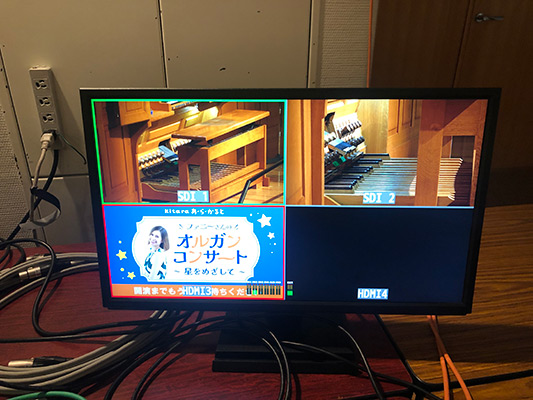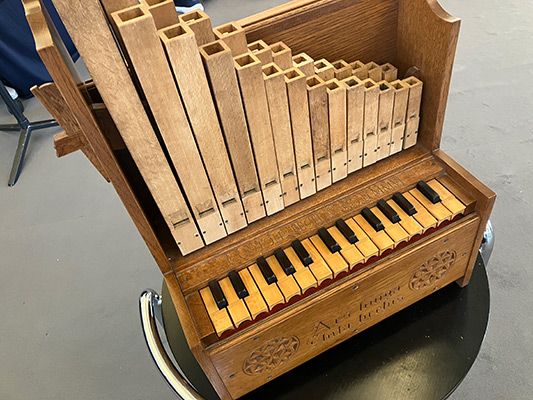オルガニストの部屋(2025年5月の記録)
オルガニスト通信
「Kitaraあ・ら・かると」に出演!
5/5(月・祝)のこどもの日に開催された「ファニーさんのオルガンコンサート」。『星をめざして』という副題の付けられたこのコンサートでは、映画『スター・ウォーズ』の「メイン・タイトル」や「きらきら星変奏曲」など、星にまつわる作品が演奏されました。Kitaraあ・ら・かると期間中のオルガン公演は毎年5歳から入場可能で、会場内の大きなスクリーンにオルガンを弾く手足を映し出し、オルガンの魅力に触れていただく大人気公演です。今年もお天気に恵まれ、800名を超えるお客様にご来場いただきました!
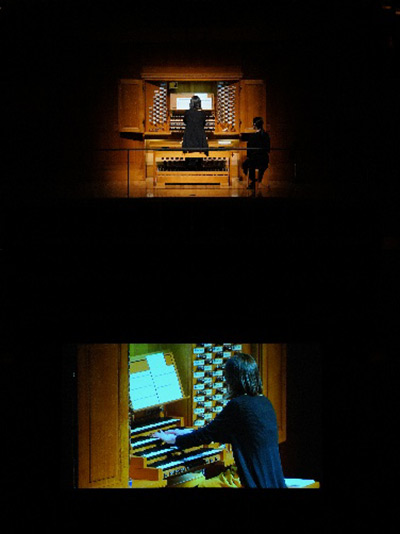
ファニー先生のオルガン特別講義、開講!
5/22(木)には「パイプオルガン特別講義」が行われました。主に音楽を学ぶ地元の大学生に向けた講義で、一般聴講は人数限定で事前にチケット購入が必要なのですが、こちらは早々と完売しました。
講義のテーマは「Ⅰ.パイプオルガンの仕組み」と「Ⅱ.作曲家・楽譜・演奏者・聴衆のつながり」の2つ。演奏やクイズを交えながらの講義は「分かりやすくて楽しかった」、「とても興味深く、勉強になった」と、ご来場の皆様にとって充実した内容だったようです。
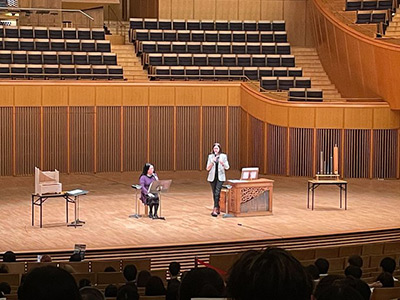
北星学園大学で演奏しました!
5/24(土)、ファニーさんは北星学園大学チャペルで開催されたパイプオルガンコンサートに出演しました。
こちらのコンサートの副題は大学の名前にちなんで『北の星に向かって』と付けられ、ヴィエルヌの「太陽への賛歌と夕べの星」やオーベルタンの「星のためのソナチネ」などのオルガン作品を披露しました。
5月は「星」に関連する作品を演奏する機会が多かったファニーさん。キラキラと美しい音色が会場いっぱいに響き渡っていました。
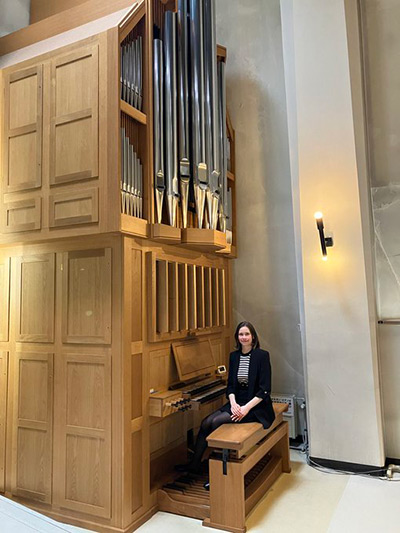
ファニーさんの
マンスリーブログ

5月初旬のゴールデンウィークに、Kitaraあ・ら・かるとの中で「星をめざして」というコンサートを行いました。星をテーマに、さまざまな様式や時代、世界観の作品を対比させました。私は新しい作品を皆さまに紹介するのが大好きで、このようなテーマであれば、よく知られた作品とあまり知られていない作品とを織り交ぜながら、作品同士の一貫性を保つことができます。
音楽を聴くときに、馴染みのあるメロディーやリズムを耳にすると、安心できたり、嬉しくなったりします。ですが、知っている曲ばかりに固執してしまうと、見逃してしまうものもあります。新しい音楽との出会いが新たな発見への第一歩となり、すぐに、「大好き」の世界が育ち始めます。食べ物で例えるなら、子どもの頃はお寿司にワサビが入っているのを少し不思議に思ったことがあるかもしれません。ですが、その組み合わせに思い切って挑戦し、新しい味を発見できるというのは、なんて素晴らしいことなのでしょう!しかも、その新しい味が今ではなじみ深く、大好きな味のひとつになっているかもしれません。これは音楽でも同じで、馴染みのない曲が、自分のお気に入り曲に仲間入りすることだってあります。音楽も味覚と同じで、磨いて育てることができるんです。詩的なテーマを選ぶことで、モーツァルト、ジョン・ウィリアムズ、ルイ・ヴィエルヌ、ヴァレリー・オーベルタンの作品をひとつにまとめることができ、よく知られた作品とあまり知られていない作品を織り交ぜることができました。
5月には、オルガンの歴史や作曲方法についての講義を行う機会がありました。この講義では、オルガンの進化をさかのぼってたどっていきました。さらに、Kitaraの巨大なオルガンやポジティフオルガンも紹介しました。合同会社アルザスのおかげで、持ち運び可能な手作りオルガンを皆さまに披露することができました。この小さなオルガンには27音の鍵盤があり、(アコーディオンのように)空いている手で風箱を操作します。初めて演奏しましたが、非常に興味深かったです。講義では、楽譜の書き方の進化についても段階ごとに振り返っていきました。時代と共に記譜法は大きく進化してきました(ネウマ譜、オルガンタブラチュアなど)。今日でも、楽譜の書き方にはさまざまな方法が存在しています(グラフィックスコア、ギタータブラチュアなど)。
5月下旬には、市内の北星学園大学でオルガンリサイタルを開催しました。この758本のパイプを有するオルガンは、2012年に大学の50周年を記念してチャペル内に設置されたものです。マナ・オルゲルバウが保守管理するこの小さなオルガンは、バッハ作品の演奏に最適です。コンサートでは、J.S.バッハのパッサカリアなどを演奏しました。
At the beginning of May, during Golden Week, I gave an organ concert entitled "Towards the stars" as part of the Kitara a la carte concert program. I contrasted pieces from different styles, eras and universes around the theme of the stars. I love introducing new works to the public, and this type of theme allows me to alternate well-known pieces with more confidential ones, while maintaining coherence between the pieces.
When we listen to music, we often feel comforted or excited when we recognize familiar melodies or rhythms. But if we only stick to what we know, we might be missing out. Encountering new music can be the first step to a new discovery-and soon, our world of "favorites" begins to grow. Here is a culinary example: When you were a child, you may have found it a bit strange that wasabi was included in your sushi. But what a pleasure to have dared to try this mixture and to have discovered a new flavor! What's more, this new taste may now be part of the flavors you're familiar with and love. It's a bit the same with music, where certain unfamiliar sounds can end up becoming part of our list of favorite tunes. Music, like taste, can be educated and cultivated. Choosing a poetic theme enabled me to bring together works by Mozart, John Williams, Louis Vierne and Valery Aubertin, alternating familiar pieces with lesser-known ones.
In May, I also had the opportunity to give a lecture on the history of the organ and ways of writing music. I retraced some of the stages in the organ's evolution. I presented the great Kitara organ and the positive organ. Thanks to the Alsace organ builder, I was also able to present the portable organ to the public. This little instrument has a 27-note keyboard, and you operate an air reservoir with your free hand (similar to an accordion). It was the first time I'd played it, and it was very interesting. During the conference, we also retraced some of the stages in the evolution of score writing. Over the years, music writing has evolved considerably (neume writing, organ tablature, etc.). Even today, there are many different ways of writing music (graphic score, guitar tablature, etc.).
At the end of May, I gave an organ recital at Hokusei Gakuen University in Sapporo. This 758 pipes instrument was installed in the chapel in 2012 to celebrate the university's 50th anniversary. It's a small instrument maintained by the Mana Orgelbau company, and is ideally suited to playing Bach pieces. During this concert, I played J.S. Bach's Passacaglia, among others.
